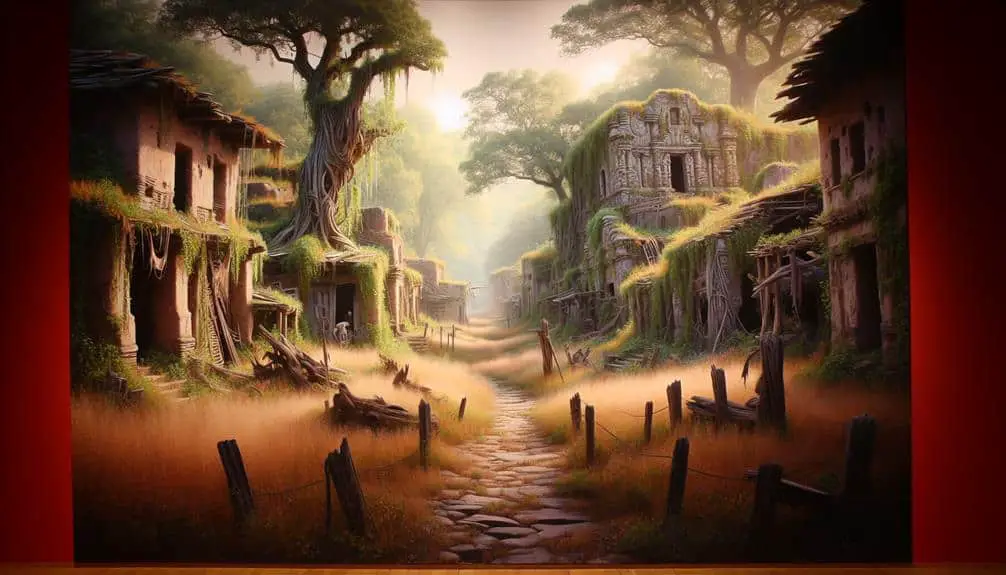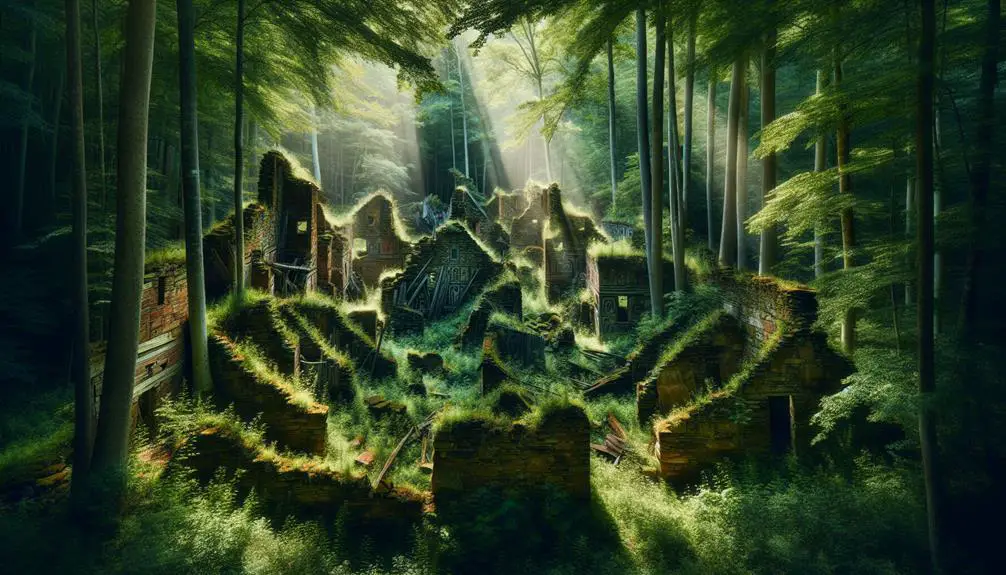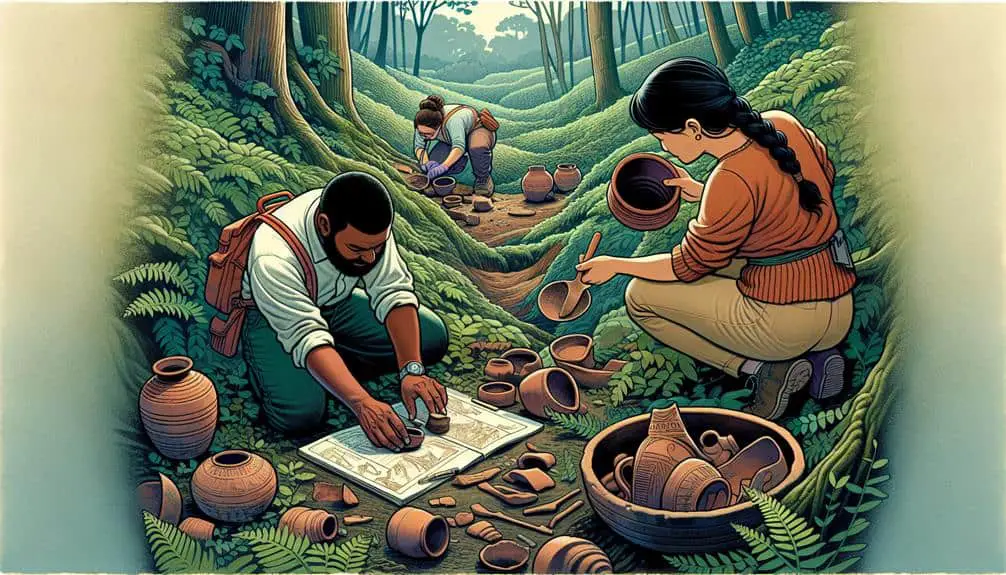Explore Native American ghost towns to uncover the intriguing past of abandoned settlements. Archaeological findings shed light on ancient communities, their customs, and reasons for desertion. Factors like environmental challenges and economic shifts played a role in their decline. These ghost towns hold cultural significance, offering a window into the beliefs and daily life of past inhabitants. Preservation efforts face obstacles like erosion and lack of resources. Touring these sites allows you to step back in time and appreciate the historical legacy left behind. The stories of resilience and heritage preserved in these towns are waiting to be discovered further.
Key Points
- Historical landscapes reveal reasons for abandonment.
- Economic changes and isolation contributed to desertion.
- Ghost towns preserve cultural heritage and beliefs.
- Challenges in preservation include environmental factors and funding.
- Touring offers insights into past lives and traditions.
Origins of Native American Ghost Towns
The origins of Native American ghost towns can be traced back to a variety of historical, cultural, and environmental factors that led to the abandonment of these settlements. Archaeological discoveries have shed light on the once vibrant communities that existed in these historical landscapes. Through excavations and research, archaeologists have uncovered clues about the daily lives, structures, and beliefs of the people who inhabited these towns.
Examining the historical landscapes where these ghost towns are located offers valuable insights into the reasons behind their abandonment. Factors such as changes in trade routes, conflicts with neighboring tribes, natural disasters, or even shifts in climate patterns played a significant role in the decline of these settlements. By studying the artifacts left behind and analyzing the layout of the towns, historians can piece together a more thorough understanding of what led to their eventual desertion.
Understanding the origins of Native American ghost towns provides a window into the past, allowing us to appreciate the complexities of history and the resilience of indigenous communities.
Factors Contributing to Abandonment
Exploring the multifaceted reasons behind the abandonment of Native American ghost towns reveals a complex tapestry of historical, cultural, and environmental factors at play. Environmental pressures, such as droughts, soil erosion, and natural disasters, often played a significant role in the decline of these settlements. Harsh climates and limited access to resources made it challenging for communities to thrive and sustain themselves over time.
Additionally, economic changes also contributed to the abandonment of many Native American ghost towns. The shift from traditional subsistence practices to a more market-based economy disrupted the livelihoods of these communities. As trade patterns evolved and industries changed, some settlements were left isolated and economically marginalized. The lack of viable economic opportunities forced residents to seek better prospects elsewhere, leading to the gradual abandonment of once-thriving towns.
Cultural Significance of Ghost Towns
Unearthing the cultural significance of Native American ghost towns exposes a rich tapestry of historical heritage and societal values deeply ingrained in these deserted settlements. These ghost towns serve as tangible connections to the spiritual beliefs and practices of Native American communities, reflecting their deep-rooted spiritual connections to the land and their ancestors. The remnants of abandoned structures and artifacts found in these ghost towns offer valuable insights into the historical interpretations of how these communities lived, worked, and interacted with their environment.
Exploring the cultural significance of these ghost towns provides a window into the past, allowing us to understand the beliefs, traditions, and daily lives of the Native American peoples who once inhabited these now-desolate areas. The preservation of these sites is essential for maintaining this link to the past and honoring the legacy of these communities. By studying these ghost towns, we can gain a deeper appreciation for the rich cultural heritage and historical significance they hold within their decaying walls.
Preservation Efforts and Challenges
To understand the challenges and efforts involved in preserving Native American ghost towns, it's essential to evaluate the impact of environmental factors on the decay of these historical sites. Challenges in preserving these ghost towns stem from a variety of factors, including natural processes like erosion, weathering, and vegetation overgrowth, as well as human-related activities such as vandalism, looting, and urban development. Preservation efforts often focus on implementing conservation strategies to mitigate these challenges. These strategies may involve stabilizing structures, controlling vegetation growth, and establishing protective measures to prevent further deterioration.
One of the main challenges faced in preservation efforts is the lack of funding and resources. Limited financial support can hinder the implementation of conservation projects and essential maintenance tasks. Additionally, the remote locations of many Native American ghost towns make access difficult, further complicating preservation efforts. Collaborative initiatives involving tribal communities, government agencies, and heritage organizations are pivotal in overcoming these challenges and ensuring the protection of these culturally significant sites for future generations.
Touring Native American Ghost Towns
When exploring Native American ghost towns, travelers can uncover the rich history and cultural significance of these abandoned settlements. Exploring ruins left behind by ancient civilizations offers a glimpse into the lives and traditions of the people who once inhabited these areas. The historical significance of these ghost towns lies not only in the architectural remnants but also in the stories and heritage they hold.
Touring Native American ghost towns provides a unique opportunity to connect with the past and appreciate the resilience of indigenous communities. By walking through these abandoned sites, visitors can gain a deeper understanding of the challenges and triumphs faced by the people who called these places home. The remnants of dwellings, pottery fragments, and petroglyphs found in these ghost towns serve as tangible links to a bygone era.
Frequently Asked Questions
Are There Any Specific Rituals or Ceremonies Associated With Native American Ghost Towns?
In Native American ghost towns, ceremonial practices are deeply intertwined with spiritual beliefs. These rituals, passed down through generations, honor ancestors and the land. They serve as a bridge between the past and present, connecting communities.
How Do Native American Communities View the Concept of Ghost Towns in Modern Times?
In modern times, Native American communities hold diverse perspectives on ghost towns, viewing them as poignant reminders of cultural significance or as unsettling relics. Community perspectives vary greatly, reflecting nuanced interpretations of history and heritage.
What Role Do Archaeologists Play in Uncovering the History of Native American Ghost Towns?
Archaeologists play an important role in uncovering the history of Native American ghost towns. Through their excavation techniques, they reveal artifacts and structures that hold immense cultural significance, shedding light on the past lives of these communities.
Are There Any Supernatural Beliefs or Legends Surrounding Native American Ghost Towns?
Enter the world of Native American ghost towns, where paranormal tales blend with cultural importance, crafting a tapestry of enigma and heritage. Myths murmur through deserted streets, resonating the souls of the past.
How Do Native American Tribes Collaborate With Government Agencies or Conservation Groups to Preserve Ghost Towns?
In collaborative efforts, Native American tribes and government agencies apply preservation techniques to safeguard ghost towns. Working together, they utilize historical knowledge and modern conservation strategies to guarantee these sites retain their cultural significance.



